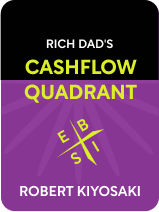

This article is an excerpt from the Shortform book guide to "Rich Dad's Cashflow Quadrant" by Robert T. Kiyosaki. Shortform has the world's best summaries and analyses of books you should be reading.
Like this article? Sign up for a free trial here .
What does the ESBI quadrant represent? What does each letter stand for? Can you be in more than one income quadrant simultaneously?
Robert Kiyosaki’s ESBI quadrant represents four ways of generating income: E (as an employee), S (as a self-employed or a small-business owner), B (as a big-business owner), and I (as an investor). The way you generate income defines your quadrant, not what you do to earn it. You can, and in many cases should, generate income in multiple categories.
Keep reading to learn about the key characteristics of each quadrant.
Robert Kiyosaki: ESBI Quadrant Explained
Most people believe that the key to wealth is getting a “good,” high-paying job. But according to Kiyosaki, the type of income you generate is more important than the type of work you do. His ESBI quadrant represents the four types of income:
- Employees (E)
- The self-employed and small business owners (S)
- Big business owners (B)
- Investors (I)
According to Kiyosaki, the first two income categories, employees (E) and the self-employed and small business owners (S), are usually dead-ends on the road to wealth. The other two categories, big business owners (B) and investors (I), are the most conducive to accumulating wealth because those are the categories in which you can develop passive income in the form of assets.
The E and S Categories: The Traditional Path
Traditional wisdom tells us to go to college to get a stable “good job” that will pay enough for a comfortable life and provide retirement benefits. That job is usually in the Employee (E) or Self-employed (S) category.
In the E category, employees generate income by agreeing to do work in exchange for a salary. They have a boss and a paycheck. Kiyosaki says employees choose the E category because they value security and certainty. Traditional thinking says E category jobs are stable because they offer steady income and a clear job description. But there are downsides—Kiyosaki says the biggest disadvantage of an E category job is lack of control over your own work.
(Shortform note: While Kiyosaki is quick to point out the downsides of being an employee, many people seek out E category jobs because they enjoy work they can only do in the E category. Professors, researchers, chefs, and teachers, for example, all make a salary and often attract people interested in the particular kind of work offered in the E category.)
In the S category, small business owners and the self employed are their business. They are their own boss, and they can also be the boss of other people, but without their labor, expertise, and management, their businesses can’t run. Their income is the profit from their business. Kiyosaki says people choose the S category because they value security and excellence in their work. According to Kiyosaki, people in the S category see it as the most stable way to generate income because they have the most control. The biggest disadvantage to trying to make a living in the S category is that most small businesses fail.
(Shortform note: Kiyosaki doesn’t mention that one of the biggest dangers of self-employment or owning a small business is not being able to fully plan for the amount of money you’ll make within a given period. E category workers are subject to job insecurity, like a round of layoffs because of trouble at the company or an economic downturn, but an S category worker’s job is also inherently at least a little insecure because they are not in a long-term contract with an employer.)
Kiyosaki notes that in the E and S categories, the harder you work, the more you have to work. As you work hard and become more successful in the E and S categories, you gain responsibility, which translates to more work. Even though your pay may jump, you’ll have less time to enjoy yourself spending it.
While these categories offered security in the 20th century, Kiyosaki argues that changes in the economy mean that they’re anything but secure in the 21st century. Kiyosaki lists five reasons the E and S category job trajectory no longer provides the “good jobs” of the past and is instead now a trap for job dependency.
The B and I Categories: The Way to Wealth
Kiyosaki says that while lower-, middle-, and even upper-middle-class parents teach their kids the out-of-date financial path we just outlined, rich parents teach their kids the income generation strategy of the Business owner (B) and Investor (I) categories.
While in the E and S categories you generate income in exchange for the work you do, in the B and I categories income comes primarily from assets you own. According to Kiyosaki, this is the surer path to financial freedom.
People in the B category control not only a business, but a business system. If they leave, the work still gets done. People in the B category own their business and generate income by its profit, though they no longer do the day-to-day labor of making it function. A B’s income is the profit from their business, and their business is considered an asset. B’s need to be skilled in delegation and leadership, as well as have a high degree of financial literacy.
| The B Category vs. the S Category The distinction between S’s (small business owners) and B’s (big business owners) is subtle, in part because B’s often start off as S’s. For example, when a tutor sells her expertise and teaching abilities, she is her own product and her own business, which puts her in the S category. However, when the tutor becomes the owner of a tutoring company, she owns the system that finds and trains tutors, connects students to tutors, markets the service, and takes care of logistics. The tutoring company owner profits from the work and time of the E category tutors she hires. She’s now in the B category. |
In the I category, investors commit money (called capital) to something and expect to make a profit. Beyond the initial investment, they don’t have to work day to day like those in the other categories do. Instead, their livelihood comes in the form of assets that generate passive income. Examples of passive income include dividends from stocks, interest on bonds, and rental income. I’s need to be comfortable with risk, since managing risk is the foundation of investing.
Kiyosaki says the best path to wealth is to make a significant amount of money in the B category and then use that capital as an investor in the I category. The kind of wealth that provides financial freedom is almost always generated in the I category, where it compounds without your labor.
(Shortform note: You only need to generate B category-level capital in order to invest if you’re aiming to be a capitalist. While Kiyosaki devotes a lot of space to advocating readers set their sight on that kind of wealth, you don’t need to own a B-category business to invest at a smaller scale, even if you’re aiming to “cross over” to living on passive income. The central function of investing remains the same whether you’re a high-flying B or a worker in the E or S categories investing for retirement.)
The reason B and I income is a much surer bet for generating wealth than E and S income is, as we previewed, the fact that assets are the way to compound your money without your labor. The income you generate from assets is called passive income. While in the E and S categories, your income minus your expenses and liabilities equals the money you have to live on, in the B and I categories, your income equals passive income from your ever-compounding assets minus your expenses and liabilities.
Success in the B and I categories requires understanding a different kind of logic and adopting a different value system than the logic and value system of the E and S categories. In the B and I categories, you:
- Make yourself, not other people, rich. If you are not the person most upstream from your labor, someone else is profiting off you.
- Profit from other people’s money and labor. By owning a system that runs on labor that’s not your own, or by investing with other people’s or a bank’s money, you can eventually gain income that you don’t have to work for every day.
- Know that society rewards wealth. Beyond the fact that a bigger investment can yield bigger returns, society rewards wealth in the form of tax advantages.
| Should B’s and I’s Make Money for Everyone Else? Many people, usually on the political left, believe people in the B and I categories should make the government rich, so the government can help those who need it. Between 2008 and 2015, about 30 Fortune 500 companies paid nothing in U.S. taxes. While the Obama Administration lowered the corporate tax rate slightly during his presidency, the Trump Administration’s 2017 tax cut lowered the corporate tax rate from 35% to 21%, roughly doubling the number of major companies that paid nothing or less in taxes. As of fall 2021, Republicans and Democrats in the U.S. Congress are debating the size of a post-Covid-19 spending bill that Democrats, who want to spend a larger sum than Republicans, say will be paid for primarily by increasing the tax burden on the rich. |

———End of Preview———
Like what you just read? Read the rest of the world's best book summary and analysis of Robert T. Kiyosaki's "Rich Dad's Cashflow Quadrant" at Shortform .
Here's what you'll find in our full Rich Dad's Cashflow Quadrant summary :
- Why the traditional path of college to career doesn't work
- Which types of income will lead you to financial freedom
- An in-depth look at Robert Kiyosaki's four cashflow quadrants







This blog is a very informative source . It explains the concept, advantages, disadvantages, and challenges of self-employment, as well as some examples and tips.